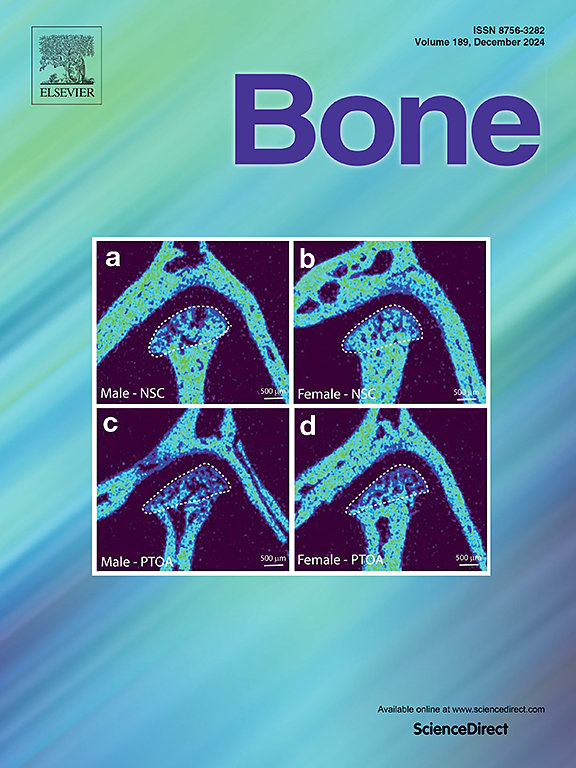衰老对骨折损伤免疫和骨膜反应的影响
IF 3.6
2区 医学
Q2 ENDOCRINOLOGY & METABOLISM
引用次数: 0
摘要
衰老使人容易出现骨量减少和脆性骨折,这些都是代价高昂且与高死亡率有关的疾病。了解衰老如何影响骨折愈合对于开发增强老年人骨再生的治疗方法至关重要。在骨折愈合的炎症期,随着骨膜骨干/祖细胞(pSSPCs)的快速增殖和分化成骨软骨谱系,免疫细胞被招募到损伤部位,允许纤维软骨愈伤组织形成,随后完成骨愈合。无论年龄如何,骨膜间充质细胞和免疫细胞在早期骨折愈合过程中如何相互作用尚不完全清楚,这限制了我们调节这一过程的能力。为了解决这个问题,我们在单细胞水平上直接分析了从完整骨和骨折骨中分离的CD45(+)和CD45(-)骨膜细胞,这些细胞在损伤后3天收集。综合分析,通过大量rna测序、流式细胞术和组织学证实,衰老降低了pSSPC的增殖,显著降低了愈伤组织形成所需基因的表达,并增加了衰老特征。在再生阶段,即损伤后14天,老龄小鼠表现出愈伤组织矿化减少,同时Sox9表达升高,软骨含量增加,表明修复延迟。我们还发现,趋化因子Cxcl9在衰老的完整Prrx1+ pSSPCs中高度上调,这有可能直接调节其他pSSPCs,并且与骨折部位CD8+ T细胞募集增加有关。细胞间通讯分析进一步揭示了调节骨折愈合的许多间充质细胞和造血细胞类型之间复杂的相互作用,并强调了衰老对这些相互作用的影响。总之,这些结果提供了对早期骨折愈合中年龄引起的改变的见解,这可能有助于改进老年人骨折修复的治疗方法的发展。本文章由计算机程序翻译,如有差异,请以英文原文为准。

Effects of aging on the immune and periosteal response to fracture injury
Aging predisposes individuals to reduced bone mass and fragility fractures, which are costly and linked to high mortality. Understanding how aging affects fracture healing is essential for developing therapies to enhance bone regeneration in older adults. During the inflammatory phase of fracture healing, immune cells are recruited to the injury site as periosteal skeletal stem/progenitor cells (pSSPCs) rapidly proliferate and differentiate into osteochondral lineages, allowing for fibrocartilaginous callus formation and, subsequently, complete bone healing. Irrespective of age, how periosteal mesenchymal and immune cells interact during early fracture healing is incompletely understood, limiting our ability to modulate this process. To address this, we directly analyzed, in parallel, at a single-cell level, isolated murine CD45(+) and CD45(−) periosteal cells dissected from intact and fractured bones, collected three days after injury. Comprehensive analysis, corroborated by bulk RNA-sequencing, flow cytometry, and histology, demonstrated that aging decreased pSSPC proliferation, markedly reduced expression of genes required for callus formation, and increased senescence signature. During the regeneration phase, at 14 days post injury, aged mice demonstrated reduced mineralization of the callus, accompanied by elevated Sox9 expression and increased cartilage content, suggesting delayed repair. We also found that the chemokine Cxcl9 was highly upregulated in aged intact Prrx1+ pSSPCs, which has the potential to directly regulate other pSSPCs, and was associated with increased recruitment of CD8+ T cells at the fracture site. Cell-to-cell communication analysis provided further appreciation of the complex interactions among the many mesenchymal and hematopoietic cell types regulating fracture healing and highlighted the impact of aging on these interactions. Together, these results provide insight into age-induced alterations in early fracture healing, which could facilitate the development of improved therapeutic approaches for fracture repair in the elderly.
求助全文
通过发布文献求助,成功后即可免费获取论文全文。
去求助
来源期刊

Bone
医学-内分泌学与代谢
CiteScore
8.90
自引率
4.90%
发文量
264
审稿时长
30 days
期刊介绍:
BONE is an interdisciplinary forum for the rapid publication of original articles and reviews on basic, translational, and clinical aspects of bone and mineral metabolism. The Journal also encourages submissions related to interactions of bone with other organ systems, including cartilage, endocrine, muscle, fat, neural, vascular, gastrointestinal, hematopoietic, and immune systems. Particular attention is placed on the application of experimental studies to clinical practice.
 求助内容:
求助内容: 应助结果提醒方式:
应助结果提醒方式:


